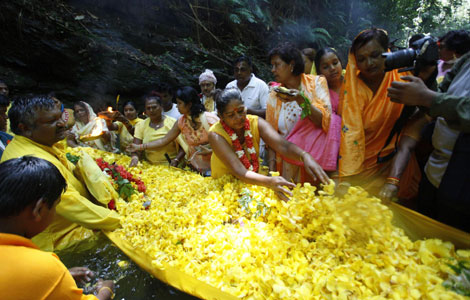Fan paintings bridge two cultures
Updated: 2013-06-19 11:23
By Chen Weihua in Washington (China Daily)
|
||||||||

For most Americans, the folding fans which they find in Chinatown stores are used to bring a cool breeze in hot summer, like in Washington DC these days.
But at the landmark Meridian House, a Louis XVI style of architecture in the US capital on Tuesday, visitors were captivated by 40 Chinese fan paintings on display. The exhibits, often a combination of painting and calligraphy, feature landscapes, flowers, birds and people in both modern and ancient times.
The art form became popular in China in the Northern and Southern Dynasties (AD 420-581) and matured during the Tang Dynasty (AD 618-907).
Randal Teague, from Rodeo China, an organization that promotes cultural exchange between China and the United States, said many people might expect to see ancient paintings and fans, which were the usual arrangement in the past.
"You see not the China of many years ago, but China of today, some done this year," said Teague, who had just visited the show.
Zhao Wei, vice-president of China National Academy of Painting, agreed, saying that Americans had lots of contact with ancient Chinese paintings, but not a lot with the modern Chinese artists who have inherited the tradition.
He said fan paintings, which are relatively small in size, match perfectly with the style of the Meridian House.
"The elegance and scholarly flavor of the fan paintings not only match well with the architecture, but also reflect the Chinese philosophy that harmony is essential," said Zhao, whose works were also on display.
The fan painting exhibition, Beautiful China, is being held on Tuesday and Wednesday by the China National Academy of Painting and Chinese People's Association for Friendship with Foreign Countries.
Li Xiaolin, president of the association, said the artist delegation she brought this time has met several US congressmen, and shown them Chinese culture, history and also the vision and hope of the Chinese people for peace.
"I sincerely hope our exhibition can serve as a bridge to bring our art and souls closer and add more delightful colors for our bilateral relations," said Li, a painter herself.
"I firmly believe the cultural exchange could be an effective channel to deepen our friendship and mutual understanding."
In front of a crowd of Chinese and Americans, Chen Ping, a professor at China Central Academy of Fine Arts, instilled Li's messages in his calligraphy work demonstration.
Stuart Holliday, president and CEO of Meridian International Center, a non-profit organization promoting global exchange and cooperation, described the fan paintings as "interesting".
"It's not just beautiful art, but a utilitarian object, an object that is used every day and it's important to Chinese culture," said Holliday, who served as US ambassador for special political affairs at the United Nations from 2003 to 2005.
Holliday said the Meridian Center provides a place for people to appreciate and understand other cultures. He and his staff have been busy traveling the world, including China, to promote cultural exchanges.
In April, the center held a photo exhibition about jazz diplomacy in Shanghai's Peace Hotel.
A similar show was held in Beijing's National Center for Performing Art a year ago. They are all part of the activities held under Meridian Center's American-Chinese Cultural Initiative (ACCI), launched in 2011 to promote cultural understanding between the two countries.
A participant of 2012 Consultations on People-to-People Exchanges in Beijing, Holliday is also looking forward to this year's consultation to be held in Washington next month.
It is part of the annual Strategic and Economic Dialogue between the two governments, following the summit between Chinese President Xi Jinping and President Obama in Sunnylands, California, 10 days ago.
While delegates from both governments may dispute a wide range of issues on trade and security at the S&ED, Holliday said there is no disagreement when it comes to cultural and people-to-people exchanges. "We actually get something done," he said.
chenweihua@chinadailyusa.com
(China Daily USA 06/19/2013 page2)

 Michelle lays roses at site along Berlin Wall
Michelle lays roses at site along Berlin Wall
 Historic space lecture in Tiangong-1 commences
Historic space lecture in Tiangong-1 commences
 'Sopranos' Star James Gandolfini dead at 51
'Sopranos' Star James Gandolfini dead at 51
 UN: Number of refugees hits 18-year high
UN: Number of refugees hits 18-year high
 Slide: Jet exercises from aircraft carrier
Slide: Jet exercises from aircraft carrier
 Talks establish fishery hotline
Talks establish fishery hotline
 Foreign buyers eye Chinese drones
Foreign buyers eye Chinese drones
 UN chief hails China's peacekeepers
UN chief hails China's peacekeepers
Most Viewed
Editor's Picks

|

|

|

|

|

|
Today's Top News
Shenzhou X astronaut gives lecture today
US told to reassess duties on Chinese paper
Chinese seek greater share of satellite market
Russia rejects Obama's nuke cut proposal
US immigration bill sees Senate breakthrough
Brazilian cities revoke fare hikes
Moody's warns on China's local govt debt
Air quality in major cities drops in May
US Weekly

|

|







